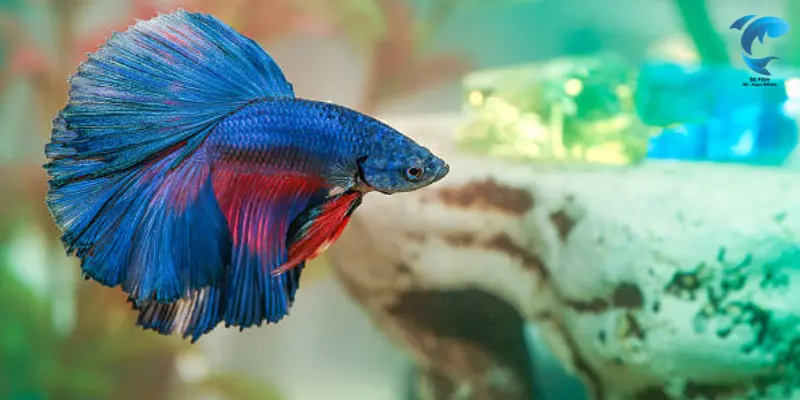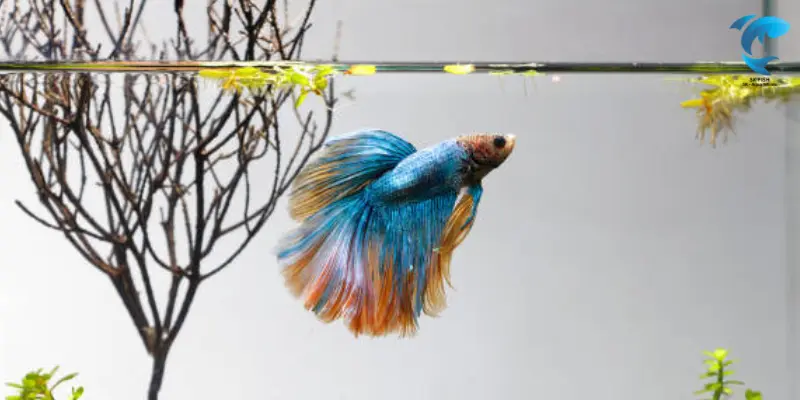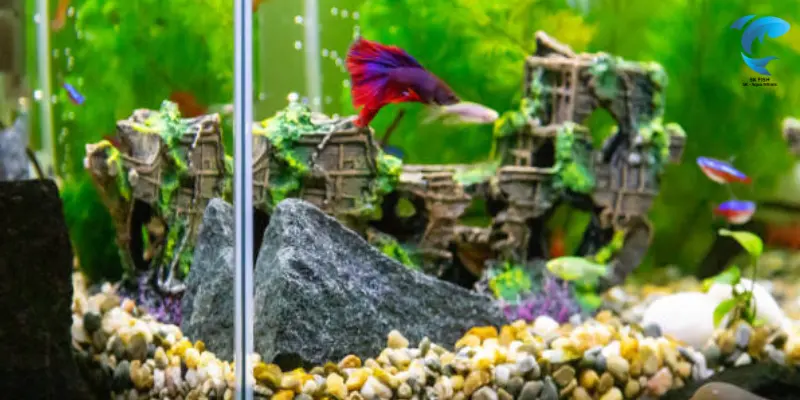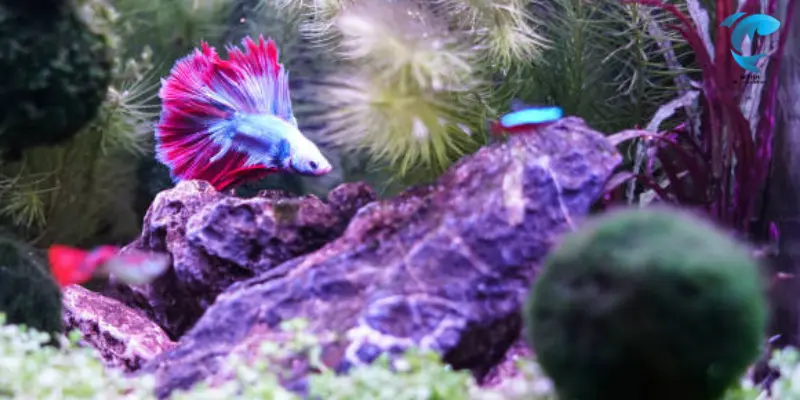Aquarium Setup for Betta: Expert Tips for Beginners in 2025
Published: 15 Mar 2025
Setting up an aquarium for betta fish requires more than just filling a tank with water and adding a fish. These stunning creatures, known for their vibrant colors and flowing fins, need a carefully designed environment to thrive. A well-planned aquarium setup not only ensures the health and happiness of your betta but also allows you to enjoy watching its natural behaviors and beautiful display.
This guide explores all the key aspects of setting up an aquarium for betta fish. From choosing the right tank size and filtration system to creating the ideal decor and water conditions, this comprehensive guide covers everything you need to know to create a perfect betta aquarium.
1. Introduction

Importance of Proper Tank Setup for Bettas
Bettas, also known as Siamese fighting fish, are native to Southeast Asia, where they live in shallow, slow-moving waters such as rice paddies and streams. As a result, bettas have unique requirements regarding their living environment. Improper tank setups can lead to stress, illness, and even premature death for your betta fish.
A proper aquarium setup for betta fish helps maintain water quality, provides a stress-free environment, and mimics their natural habitat, allowing your betta to thrive. With the proper setup, you’ll enhance your betta’s life and enjoy watching its beautiful display of colors and active swimming behaviors.
Overview of Betta Care Needs
Bettas are relatively hardy Fish but still require specific care to stay healthy. These include:
- Warm water: Bettas are tropical Fish, meaning they need warm water to maintain a stable metabolism.
- Low water flow: Bettas are not strong swimmers and prefer slow-moving water.
- Adequate hiding spaces: As territorial Fish, bettas appreciate having places to retreat when they feel threatened or stressed.
- Quality food: Bettas are carnivorous and require a high-protein diet.
- Regular water changes: Regular optimal water conditions. To maintain optimal water conditions
Meeting these needs with a well-planned aquarium setup ensures that your betta fish will live a long, healthy, and happy life.
Benefits of a Well-Planned Tank for Your Betta’s Health and Happiness
| A thoughtfully designed aquarium setup promotes your betta’s physical and mental well-being. A proper tank setup helps: |
|---|
|
2. Choosing the Right Tank
Minimum Tank Size (Recommendation: 5 Gallons)
Choosing the right tank is one of the most crucial aspects of setting up your betta’s home. While bettas can survive in smaller containers, providing them with at least a 5-gallon tank is recommended. A larger tank offers more stable water conditions, reduces the buildup of toxins, and provides your betta with more space to swim and explore.
A 5-gallon tank is the minimum size recommended, but a 10-gallon tank or larger is even better if space allows. A bigger tank is easier to maintain and gives your betta more room to thrive.

Importance of Tank Shape (Longer Tanks vs. Taller Tanks)
Betta fish are horizontal swimmers, meaning they prefer more extended tanks to taller ones. A long, wide tank gives them more space to move around and explore. Tall tanks, on the other hand, may make your betta feel confined and stressed.
When setting up a tank for your betta fish, choose a longer or higher tank. This shape mimics bettas’ natural, horizontal swimming patterns in the wild and creates a more comfortable environment for them.
Best Material Options for Betta Tanks (Glass vs. Acrylic)
The material of your tank matters not only for its appearance but also for its durability and maintenance. Most betta fish tanks are made from either glass or acrylic. Here are the pros and cons of each:
- Glass tanks: Glass is the most common and popular choice due to its durability and scratch resistance. They are also easier to clean and maintain and offer clear visibility.
- Acrylic tanks: Acrylic is lighter and offers better insulation, but it is more prone to scratches, can be more challenging to clean, and is also more prone to yellowing over time.
Both materials suit betta tanks, but glass tanks are the most reliable and cost-effective option.
Transparent Tanks for Observation
Bettas are social creatures and enjoy interaction with their owners. A transparent tank allows you to observe their behaviors, health, and environment more easily. Clear glass or acrylic tanks provide an unobstructed view of your betta’s beautiful fins and vibrant colors, making monitoring their well-being easier.
3. Filtration System
Why Filtration is Important for Water Quality
Maintaining water quality is essential for your betta’s health. Bettas are particularly sensitive to poor water conditions, and without proper filtration, toxins like ammonia and nitrites can build up, causing harm to your betta. A filtration system helps clean the water by removing waste, debris, and harmful chemicals.
Choosing a Filter with Low Flow
Since bettas are not strong swimmers, choosing a filter that provides low water flow is essential. Strong currents can stress your betta and make it difficult for them to swim comfortably.
A sponge filter is an excellent option for bettas, providing gentle filtration without disturbing the water too much. If you use a traditional filter, ensure the flow can be adjusted to a low setting or position the filter output near the water’s surface to minimize the current.
Types of Filters: Sponge Filters vs. Traditional Filters
| Types of Filters |
|---|
|
How to Adjust Flow to Suit Betta Fish
If you choose a traditional filter, ensure it has an adjustable flow rate. If the filter cannot be adjusted, you can use a sponge or foam filter cover to diffuse the flow. This will create a more comfortable environment for your betta.
Cleaning and Maintenance Schedules for Filters
Regular filter maintenance is crucial to keeping your tank and betta healthy. Clean your filter every 2-4 weeks, and replace the filter media as needed. This ensures that your filtration system works effectively and that your betta enjoys a clean and healthy environment.

4. Heating the Tank
Optimal Water Temperature for Bettas (76°F to 82°F)
Bettas are tropical Fish that require warm water to thrive. The ideal water temperature for bettas is between 76°F and 82°F (24°C–28°C). A consistent temperature within this range helps your betta maintain a stable metabolism and stay active and healthy.
Types of Heaters (Submersible, Adjustable, Pre-set)
- Submersible heaters: These are the most common heaters for betta tanks. They are placed directly in the water and provide even heat distribution. Choose a submersible heater that is appropriately sized for your tank.
- Adjustable heaters: Adjustable heaters allow you to set the exact temperature, which helps maintain a consistent environment for your betta.
- Pre-set heaters: Pre-set heaters maintain a fixed temperature, usually around 78°F. These are easy to use but may not provide the level of control that adjustable heaters offer.
How to Maintain a Stable Temperature
Use a reliable aquarium thermometer to monitor the water temperature regularly. Make sure the heater is calibrated correctly and not malfunctioning. Place the heater near the water flow to ensure even heat distribution.
Risks of Overheating and Underheating
- Overheating: If the water temperature rises too high, your betta can experience stress, oxygen depletion, and even death.
- Underheating: If the water is too cold, your betta may become sluggish and vulnerable to disease.
Maintaining a stable temperature is essential for your betta’s health.

5. Tank Substrate
Best Substrates for Bettas (Sand vs. Fine Gravel)
The substrate in your betta tank is essential for aesthetic and practical reasons. The best substrate options for bettas are sand and fine gravel.
- Sand is the best option for bettas because it is soft, smooth, and easy to clean. It also mimics their natural environment, as they are used to swimming in soft, shallow waters.
- Fine gravel: Fine gravel is also acceptable, but ensure it is smooth and not too rough. Coarse gravel or sharp-edged rocks can damage your betta’s delicate fins.
Importance of a Soft, Smooth Substrate for Fin Health
Bettas have long, flowing fins that are easily damaged by rough or jagged surfaces. A soft substrate reduces the risk of injuries and promotes healthy fin growth. Always choose a smooth, gentle substrate for your betta tank.
How Substrate Affects Water Chemistry
Different substrates can affect the water’s pH and hardness. For bettas, a neutral to slightly acidic pH (6.5–7.5) is ideal. Choose a substrate that does not drastically alter the water chemistry.
Adding Plants and Decor Over Substrate
Once you’ve selected your substrate, you can add plants and decor to your tank. Live plants like Anubis, java fern, and marimo moss balls are ideal for bettas. They provide natural hiding spots, oxygenate the water, and enhance the tank’s appearance.
6. Decor and Aquascaping
Importance of Hiding Spots
Bettas are territorial and appreciate having places to retreat when they feel threatened. Providing hiding spots, such as caves or dense plants, helps your betta feel secure and reduces stress.
Avoiding Sharp Decorations That Can Damage Betta Fins
Betta fins are delicate and can easily tear on sharp decorations. Choose smooth decor free of rough edges to keep your betta’s fins intact.
Ideal Plants for Betta Tanks (Live vs. Artificial)
Live plants like java fern, anubias, and cryptocoryne are excellent for bettas. They provide natural hiding places, help with water filtration, and create a more natural environment.
Artificial plants can be used, but they should be made of soft materials like silk to prevent damaging your betta’s fins.
Setting Up Aquascaping with Bettas in Mind
When aquascaping your betta tank, create an environment miming their natural habitat. Use plants, caves, and decorations to provide hiding spots and encourage exploration. Avoid overcrowding the tank with too many decorations, as bettas need swimming space.

Conclusion
Setting up the perfect aquarium for your betta fish requires careful planning and attention to detail. Following the steps outlined in this guide, you can create an environment promoting your betta’s health, well-being, and natural behavior. With the right tank size, filtration system, substrate, and decor, your betta will thrive in a beautiful, well-maintained aquarium.
Remember that a healthy betta is a happy betta, and the more effort you put into creating the best aquarium setup for betta fish, the more you’ll enjoy watching your betta swim, explore, and display its beautiful colors.
To set up a betta tank for beginners, follow these steps:
- Choose a 5-gallon tank for better water quality.
- Install a low-flow filter like a sponge filter.
- Use a submersible heater to maintain a stable temperature (76°F to 82°F).
- Opt for fine sand or smooth gravel for the substrate.
- Add live plants like java fern for a natural, healthy environment.
- Test and change the water regularly.
This basic setup ensures a comfortable and safe home for your betta.
Here are a few setup ideas:
- Aquascape Jungle: Use lush plants like anubias and java moss.
- Zen Garden: Go minimalist with fine sand and simple plants.
- Betta Palace: Add caves and silk plants for exploration.
- Low-Tech Planted Tank: Incorporate low-maintenance plants like java fern. Each setup provides a secure, aesthetic environment for your betta.
If you set up a tank without a filter:
- Use at least a 5-gallon tank for better water quality.
- Add live plants to help maintain water quality.
- Perform weekly water changes (20-30%) to prevent toxin buildup.
- Use a submersible heater for temperature control. Regular water testing is key to maintaining a clean environment.
When choosing a Betta Tank Setup Kit, ensure it includes:
- 5-gallon tank minimum.
- Low-flow filter or sponge filter.
- Submersible heater with a thermostat.
- LED lighting for a natural day/night cycle.
- Safe substrate and decorations. These kits provide everything you need for a betta-friendly environment.
Some tremendous live plants for your betta’s tank:
- Java fern – hardy and low-maintenance.
- Anubias – perfect for low-light conditions.
- Marimo moss balls – help with water quality.
- Java moss – offers cover and hiding spots. These plants improve water quality and create a natural, secure space for your betta.
For a 5-gallon tank:
- Use a long, rectangular tank.
- Install a gentle sponge filter.
- Keep the water temperature between 76°F and 82°F using a heater.
- Choose fine sand or smooth gravel for the substrate.
- Add live plants like java fern and marimo moss balls. Regular water changes and testing are essential to keep the water clean and safe.

- Be Respectful
- Stay Relevant
- Stay Positive
- True Feedback
- Encourage Discussion
- Avoid Spamming
- No Fake News
- Don't Copy-Paste
- No Personal Attacks



- Be Respectful
- Stay Relevant
- Stay Positive
- True Feedback
- Encourage Discussion
- Avoid Spamming
- No Fake News
- Don't Copy-Paste
- No Personal Attacks





